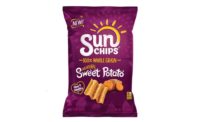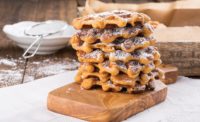With health and wellness trends leading the way across the food industry, how does a sweet and indulgent category like dessert fare? Apparently, consumers aren’t quite ready to let go of their beloved desserts.
Overview | Bread | Tortillas | Sweet Goods | Snack Cakes | Pizza | Desserts | Cookies | Buns & Rolls | Bars | Breakfast Products
Market data
Data from IRI, Chicago shows that sales of cakes and pies have held steady in the 52 weeks ending March 25, 2018. Dollar sales of cakes grew 2.31 percent to $1.52 billion. Notable growth came from The Hershey Co., which posted 29.14 percent growth to $25.3 million. Rich Products Corp. cakes were also strong sellers, with 51.37 percent growth to $16.9 million. Private label cakes lead the segment by a large margin, off 0.21 percent to $1.1 billion for the year, with just under 70 percent market share.
Pie sales were also steady, growing 2.10 percent over the course of the year to $4442 million, per IRI. Again, private label leads the segment, but was likewise off a bit, down 0.78 percent to $321.3 million. Jessie Lord Bakery grew 7.64 percent to $28.9 million, and Specialty Bakers grew 15.86 percent to $24.3 million.
Frozen cheesecakes likewise saw positive growth for the period, up 3.13 percent to $139.1 million. While private label and the Sara Lee business of Hillshire Brands hold a strong lead, both saw sales drop slightly for the year. Meanwhile, The Cheesecake Factory grew 14.66 percent to $21.4 million.
Frozen pies took a slight dip for the year, down 1.58 percent to $500.3 million. While Schwan Co. and Conagra hold a commanding lead of the segment, private label showed strong growth, up 28.57 percent to $12.5 million.
Refrigerated cheesecakes remain popular, showing strong growth again this year, up 10.05 percent to $304.1 million, per IRI. Private label cheesecakes lead the pack and grew 3.47 percent to $178.6 million. The Father’s Table also saw growth, up 6.42 percent to $56.3 million. And Kraft Heinz Co. has found an audience for its unconventional approach toward cheesecake via its Philadelphia Cheesecake Cups launched in early 2017, a line that grew 754.69 percent to $24.1 million.
Looking back
Trends in cakes, pie and cheesecakes are moving toward higher quality and back-to-basics artisan products. “There is a pretty significant increase in more artisan pie bakers who are entering regional markets,” says Rick Hoskins, president of Colborne Foodbotics, Lake Forest, IL. “As consumers begin having more choices to find higher quality store-bought pies, large-scale manufacturers are working hard to make a comparable product.”
For some, this means providing a higher fruit ratio in fillings, Hoskins says. To that end, Colborne Foodbotics has introduced new filling technology that allows users the ability to automatically deposit fruit fillings with more than 80 percent fruit pieces.
Manufacturers are also appealing to artisan trends by offering flaky pie crusts, as opposed to the “shorter, mealy” pie crusts of yesteryear, Hoskins says, which weren’t consistent with what consumers would make in their own kitchens. “Those days are over,” he adds. “Most of our customers who transitioned away from these types of products have gone back to the traditional flaky short pie crust.” Colborne Foodbotics helps fuel this trend with new sheeting and trimming technology that can help brands deliver a tender and flaky crust.
Sometimes adhering to tradition comes in the form of a nostalgic flavor profile. Schwan Co. launched a S’mores Crème Pie cobranded with Hershey’s chocolate under its Edwards brand last year. It’s made with a vanilla cookie crust and a layer of chocolate crème filling studded with graham-style cookie pieces, topped with a toasted marshmallow meringue and chocolate drizzle.
Brand recognition can go a long way in commanding shopper appeal—something Café Valley has long understood. The company released a Dr. Pepper Cake last year to join its lineup of other cobranded soda cakes like 7UP, Orange Crush and A&W Root Beer.
Looking forward
The industry is also responding to trends with back-to-basics clean labels and ingredients that consumers would find in their own pantries. “Customers want traditional, decadent sweets, but do not want artificial ingredients,” explains Tim Williams, director of sales and technical service, Lawrence Foods, Inc. (LFI), Elk Grove Village, IL. “LFI has done a good job replacing sugars, hydrocolloids, anti-microbial, and preservative systems with alternatives that our customers define as clean label.”
Adjacent to the clean label trend is the better-for-you trend, which is also making its unique mark on desserts.
Blue Diamond Almonds Global Ingredients Division, Sacramento, CA, recently launched a 100 percent pure and premium almond oil. “The clean and mild flavor of Blue Diamond Almond Oil lets other product flavors shine, making it uniquely positioned for use in the bakery and dessert category,” says Jeff Smith, director of marketing. The oil is low in saturated fat and high in omega-9 fatty acids.
A new fall 2017 launch from Barry Callebaut, Chicago, also appeals to clean labels. The company’s new Bensdorp Clean cocoa powder provides traditional cocoa color and flavor but is alkalized with baking soda, allowing brands to label packaging with “processed with baking soda” claims rather than those stating “processed with alkali.” Barry Callebaut also recently launched Niu, a chocolate sweetened with coconut.
Shrinking serving sizes can also resonate with shoppers. “Consumers love dessert, and what we’re seeing is demand for mini dessert cakes, from updated nostalgic favorites to new classics,” says Williams. “While consumers may be more health and calorie conscious, they are willing to skimp in other areas of the meal in order to enjoy dessert.” Individualized packaging and single-serve offerings are driving growth, as they increase portability and convenience while keeping serving sizes in check. The idea of dessert as a post-meal occasion is falling by the wayside, he says, as consumers are increasingly accepting dessert as an “anytime occasion.”
When it comes to flavor, unlike other categories that are experiencing a renaissance in experimental flavors, consumers in the dessert category tend to want to stick to the tried and true. All-natural flavors derived from botanicals, fruits and nuts still find favor, says Smith.
Where manufacturers can get creative is in how they play with these flavors. “Combining multiple flavors for maximum impact is hot with consumers right now,” says Williams. “For pies, we see fruit combinations such as lemon blueberry, strawberry rhubarb, and apple cranberry. For cakes, we see decadent icings with candy or confectionery accents.”
According to Seema Kedia, senior manager of marketing and sustainability, Barry Callebaut, layering is one way that brands and bakers can play with flavor but also create “Instagrammable” moments for their favorite indulgences. “The social sharing of consumption is as important as the eating experience, and when showcasing desserts, layers make for a great visual,” she says. “For pies in particular, you see something similar with intricate lattices being utilized more frequently, again for visual appeal.”
Looking ahead, the dessert market will continue to be marked by innovation in better-for-you options as well as new packaging formats that increase portability, says Smith, making it easier than ever for consumers to “find a balance between a healthy diet and indulging in their favorite desserts with moderation.”
Overview | Bread | Tortillas | Sweet Goods | Snack Cakes | Pizza | Desserts | Cookies | Buns & Rolls | Bars | Breakfast Products









